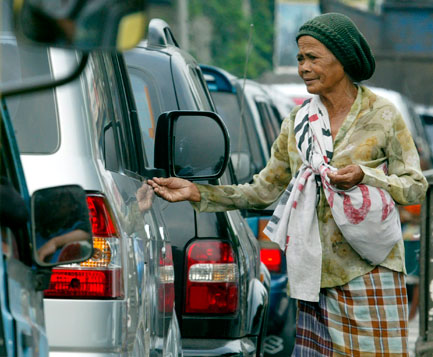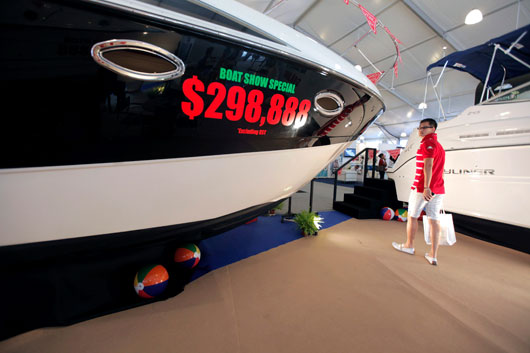Throughout much of Southeast Asia these days, the streets look rather similar: Luxury SUVs inch along the congested roads while labourers on rusted bicycles overtake them.
On the surface, it looks like a vision of growth and development. But make no mistake, unless Asean nations figure out how narrow the divide is between the haves and have-nots, the region may face some rough times ahead.
Over the past two decades, individual countries within the regional bloc have been slowly levelling out their economies. To be sure, Myanmar is no Singapore and will likely never be, but the fact they can both come to the table as players to discuss growth and economic integration represents a sea change.
However, if the gap between nations has somewhat narrowed, another more insidious one has emerged. The divide between wealthy and poor individuals continues to grow. And as the ten Asean nations become increasingly cleaved along class lines, instability inside these countries could threaten an emerging regional market.

Christine Lagarde, managing director at the International Monetary Fund (IMF), recently highlighted the risk that “in a high-speed global economy, too many people get left behind. In too many places, we see signs of rising inequality – which in turn can threaten sustained growth, economic stability and social cohesion,” she said when visiting Cambodia in December. “This is a live issue in Asia. Over the past quarter-century, inequality has risen faster in Asia than in any other region.”
Political scientist Carlyle Thayer, an emeritus professor at the University of New South Wales in Australia explained that “generally […] literature sees a connection between disparities in income and the propensity for social unrest. A large wealth gap means that resources are denied to those at the bottom.”
To look at a nation’s growth rates alone tells only part of the story. In order to get a full sense of how a country is doing, economists and analysts are increasingly looking at its Gini coefficient – a measure of income inequality calculated by measuring the distribution of wealth. Countries with Gini coefficients close to 0, such as Scandinavian nations, boast more wealth equality while those closest to 1, such as Saharan countries, are more unequal. To have a 1, a country would have to have all its wealth held by a single person.
Tucked among those high-Gini nations are a number of Asean states. Of 136 countries for which there is data, the CIA World Factbook ranks Thailand at the 12th most unequal within Asia. Only Hong Kong is higher at number 11. Singapore is ranked 26, Malaysia 33 and the Philippines 42. For some countries, the latest data comes from 2008 – given their rates of increase in inequality, it is possible that other Asean nations might have crept up into the top third of unequal countries.
Meanwhile, as the regional bloc inches closer to the self-imposed 2015 deadline for economic integration, observers are wondering what the impact might be for the Asean Economic Community (AEC). Matthew Bock, a Jakarta-based analyst who has been researching inequality in Asean, has recommended the Secretariat directly monitor income inequality when developing the AEC. He is hopeful that a regional strategy would encompass such considerations.
“Asean has always leaned towards more inclusive development in order to try and establish an equitable, stable region,” he said. “Integration is not just about improving groups at the top.”
But Asean-wide policies are only as good as the countries implementing them. Even if the body succeeds in creating an economic model that raises all ships, individual nations will still have to contend with rising inequality within their borders.
Throughout rapid-growth nations, income inequality is generally acceptable – up to a point, argued Bock. “When you have too much disparity, there’s a point at which absolute poverty is less important and relative poverty becomes more important. Someone’s life is being improved somewhat – they have food security, reasonable access to education, to a job,” he said. “But there is a point at which a person says: ‘I’m just getting by and everyone else is getting rich.’ That’s the point at which discontent may foment with the potential for mobilisation. And that’s where the problem of instability may rise – under conditions of high relative poverty.”
Does it really matter? Singapore’s historically impressive economy shows few signs of weakening, as does the Philippines’ and Thailand’s. But over time, high rates of inequality can slow growth and even lead to unrest and political instability. Across the region, there are hints this model is at work.
Late last year, for instance, Singapore made international headlines after a research report revealed the depth of inequality and urged the nation to set a poverty line. The report, issued by the Singapore Management University’s Lien Centre for Social Innovation, argued that inequality had grown at an unusual speed and that “rising inequality combined with evidence of poverty indicates that the poor are being left further behind”.

Indonesia, too, which for decades was considered a success story in how to balance growth and economic equality, has been slipping in recent years. Though it still has a relatively low Gini coefficient and remains near the bottom of the rankings, inequality has increased sharply. In 2002, the coefficient was 0.297. In 2011, it hit 0.381.
In Cambodia, impressive gains in poverty reduction have been matched by growing discontent. During the 2013 national elections, the opposition was able to tap into that financial discontent so successfully that it won nearly half of the popular vote – an unprecedented gain in a country that has been run by the same leader for 28 years.
“Generally, the social science literature sees a connection between disparities in income and the propensity for social unrest. A large wealth gap means that resources are denied to those at the bottom,” said Thayer.
Apart from the question of instability, economists argue that the impact on growth can be stark. By modelling growth scales in Asia and Latin America, researchers with the IMF predicted relatively small drops in inequality could lead to much prolonged growth.
“A ten-percentile decrease in inequality – the sort of improvement that a number of countries have experienced during their spells – increases the expected length of a growth spell by 50%,” Andrew Berg and Jonathan Ostry wrote in a 2011 IMF staff discussion note.
Over the coming months, hundreds of officials from across the region will descend upon Myanmar’s capital Naypyidaw where, doubtless, the planned AEC will be a chief priority. But as they discuss the future of such integration, they would do well to consider the words of Berg and Ostry.
“Inequality,” they wrote, “is thus a more robust predictor of growth duration than many variables widely understood to be central to growth.”
